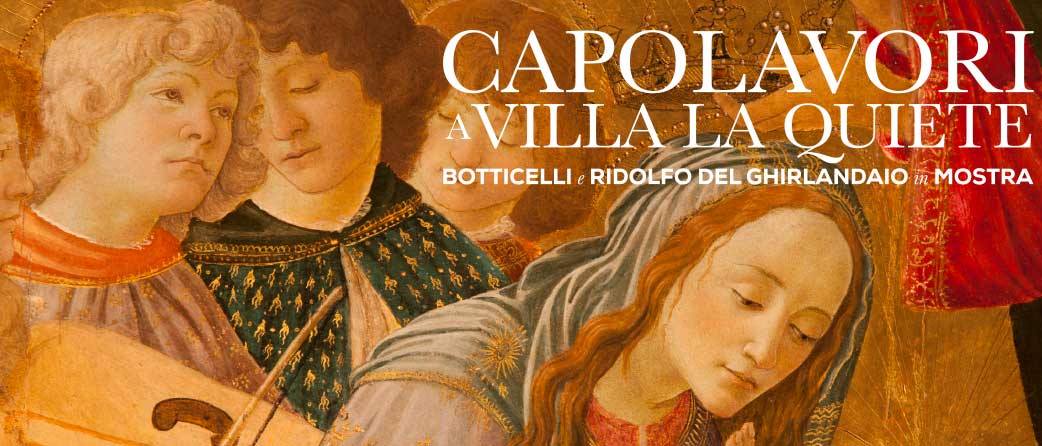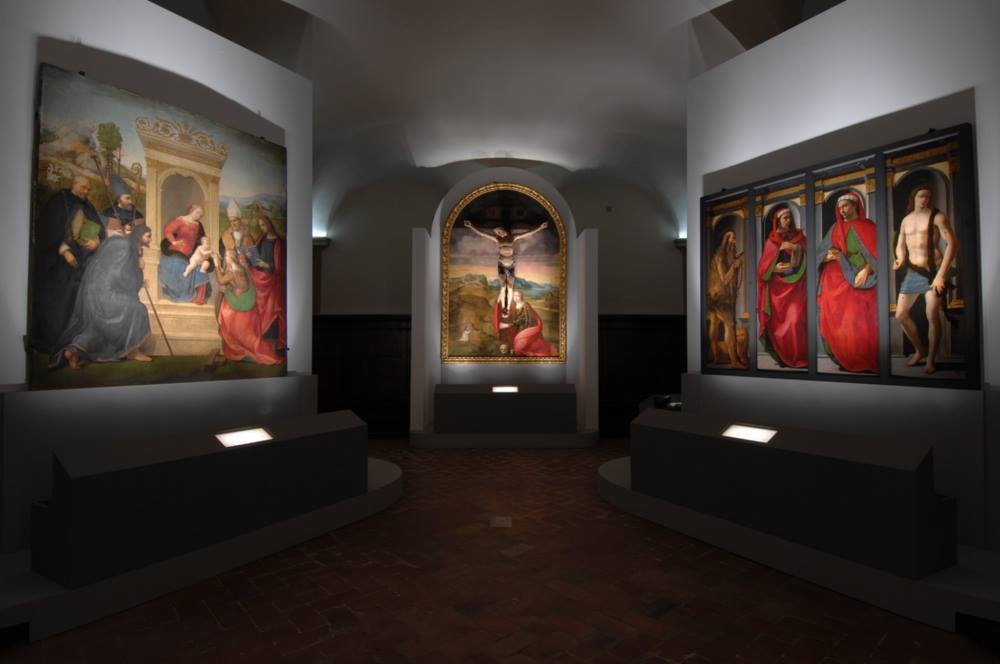
Villa La Quiete
Dal 26 luglio al 30 ottobre 2016, prorogata fino al 15 gennaio 2017
Di Tania Mio Bertolo (Università degli Studi di Firenze)
Un cantiere in corso.
Francamente è questa la subitanea impressione che ho avuto quando mi sono unita al capannello di astanti in attesa di entrare. “Capolavori a Villa La Quiete. Botticelli e Ridolfo del Ghirlandaio in mostra”, inaugurata il 25 luglio e prorogata fino ad anno nuovo, non trova spazio in nessuno dei tradizionali ambienti museali della città di Firenze solitamente adibiti ad ospitare esposizioni temporanee, bensì in una storica residenza medicea al di fuori del circuito prettamente cittadino. Per l’occasione Villa La Quiete apre le porte del suo antico refettorio, ambiente che ospita l’esposizione stessa. Le altre sale benchè custodi di preziosi arredi ed affreschi parietali non sono ancora percorribili; ma parlo appunto di cantiere in corso, perchè l’intenzione di renderle accessibili c’è.
L’assenza di una sala d’ingresso accogliente e confortevole, trattandosi di fatto di un sito non ancora del tutto musealizzato, non mi sembra motivo sufficiente per avanzare un giudizio lamentevole e negativo, quando invece il contenuto storico artistico della mostra è pregevole ed efficace.
Del complessivo patrimonio della villa, comprensivo sia degli arredi mobili ed immobili della residenza, sia degli apparati liturgici provenienti dalla chiesa fiorentina di San Jacopo a Ripoli, è esposta poco meno di una decina di pale d’altare. Il criterio di selezione è ben chiaro: le opere in mostra provengono tutte dal complesso di San Jacopo che fu sede cittadina della Congregazione delle Montalve fino al penultimo decennio dell’Ottocento, quando esse furono costrette a lasciare tale sede e raggiungere le altre consorelle che già risiedevano a Villa La Quiete. Fu in tale occasione che il patrimonio della chiesa di via della Scala si unì a quello della villa. Quest’ultima, proprietà della famiglia Medici dalla metà del secolo XV, divenne nel Seicento sede della Congregazione laica delle Ancille Minime della SS. Trinità, protetta dalle donne di casa Medici e da esse incaricata di occuparsi dell’educazione delle giovani fanciulle della nobiltà fiorentina.
Le opere sono dunque esposte nello stesso immobile nel quale da più di un secolo ormai esse stesse sono conservate. Emerge dunque una duplice continuità: sia tra i dipinti e il luogo di provenienza, sia tra gli stessi e il luogo di conservazione ed esposizione. Un ulteriore aspetto concorre a mantenere saldo questo straordinario equilibrio di comunanze: ciascuna delle opere in mostra fu realizzata nella prima metà del Cinquecento, la maggior parte di esse da pittori toscani. È infatti esposto un notevole nucleo di opere realizzate da Ridolfo del Ghirlandaio, una pala del suo allievo Michele Tosini con crocifisso ligneo scolpito da Baccio da Montelupo, una Madonna con Bambino di un pittore fiammingo, un San Domenico della Scuola di San Marco e l’Inconorazione della Vergine e Santi di Sandro Botticelli. Tutti dipinti a soggetto sacro poiché sacro era il luogo al quale essi erano originariamente destinati.
La mostra si snoda, come sopra detto, in un unico ambiente forse troppo angusto per le grandi dimensioni delle opere esposte. Tuttavia un sapiente utilizzo degli strumenti museografici ha saputo valorizzare ciascun dipinto. I pannelli sui quali sono collocate le opere, posizionati diagonalmente rispetto alle pareti del refettorio, creano per ogni dipinto un piccolo spazio raccolto. A sottolineare l’autonomia di questi spazi concorre anche la rete illuministica, dislocata in modo tale da dare risalto singolarmente a ciascuna opera. Pur nella continuità della stesso percorso espositivo e con le similarità sopra menzionate, ogni dipinto riceve magistralmente il proprio spazio nel quale dialoga intimamente con il visitatore.
Risultato di un attento lavoro di ricerca e vera occasione per mettere in mostra opere da tempo non più ammirabili, “Capolavori a Villa La Quiete” si pone in definitiva come esempio di qualità sia museologica che museografica, attenzione scientifica e valorizzazione storico artistica.
Translation by Rachyl Grussing (Istituto Lorenzo de’ Medici)
A construction site in progress.
Frankly this is the sudden impression that I had when I joined the crowd of onlookers waiting at the entrance. “Masterpieces of the Villa La Quiete. Botticelli and Ridolfo Ghirlandaio on Display”, which opened on July 25, and was extended to the new year, is not placed in any traditional museological spaces in the city of Florence that are usually used to host temporary exhibitions, but instead is found in a Medici residence very much outside the boundary of the city. For this occasion Villa La Quiete has opened the door of their ancient refectory, an environment that is itself an exhibition. Although the other rooms of precious furniture and wall frescoes are not passable, but I just spoke of a construction site in progress because the intention is to make them accessible.
The absence of a cozy entrance room, since the site is not yet completely a museum, does not seem reason enough to pass negative and unreasonable judgement, when in fact the historic and artistic content of the show is valuable and effective.
The heritage of the villa includes the moveable and immovable furnishing of the residence, both the liturgical apparatuses of the Florentine Church San Jacopo a Ripoli, has exposed a little less than ten altar pieces. The criteria for selection is clear: the works in the show all originated from the complex of San Jacopo. This was the seat of the Congregation of Montalve until the penultimate decade of the 19th century, when they were forced to leave that seat and go to the other sisters who resided in Villa La Quiete. It was on this occasion that the assets of the Church of the Via della Scala joined to that of the Villa. The latter, owned by the Medici family from the mid-15th century, in the 17th century became the the seat of the secular Congregation of the Ancille Minime of the S.S. Trinity, protected by the women of the Medici and given the task of educating the young girls of the noble families in Florence.
Therefore, the works are displayed in the same building in which they were preserved in for over a century. Thus emerges a dual continuity: both between the paintings and the place of provenance, between the same place of conservation and exposition. Another aspect contributes to keep firm this extraordinary equilibrium of commonalities: each of the works on display was built in the first half of the sixteenth century, most of them by Tuscan painters. In fact, displayed is a remarkable nucleus of works realized by Ridolfo Ghirlandaio: a piece by his student Michele Tosini with a wooden crucifix by Baccio da Montelupo, and a Madonna and Child by a Flemish painter, Saint Dominic by the school of San Marco and a Coronation of the Virgin and Saints by Sandro Botticelli. All the paintings of a religious nature are displayed as they were originally intended.
The show unfolds in an environment perhaps too small for the grand size of the works. However, a wise use of museological tools has capitalized on each painting. The panels on which the works are located, positioned diagonally to the Refectory, create for each painting a small, intimate space. To contribute to the autonomy of these spaces the illumination is positioned in order to give prominence to the individual works.
Despite the continuity of the same exhibition, and the similarities mentioned above, each painting masterfully gets their own space in which intimately interacts with the visitor.
As the result of careful research, and an opportunity to admirably showcase the works for some time, “Masterpieces of the Villa La Quiete” ultimately arises as an example of quality museological practice, scientific attention, and historical artistry.
